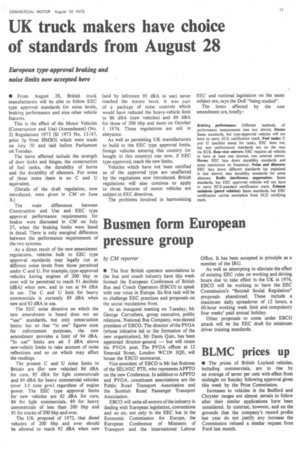UK truck makers have choice of standards from August 28
Page 13

If you've noticed an error in this article please click here to report it so we can fix it.
European type-approval braking and noise limits now accepted here
• From August 28, British truck manufacturers will be able to follow EEC type approval standards for noise levels, braking performance and nine other vehicle features.
This is the effect of the Motor Vehicles (Construction and Use) (Amendment) (No. 2) Regulations 1973 (SI 1973 No. 13/47, price 5p from HMSO) which were made on July 30 and laid before Parliament on Tuesday.
The items affected include the strength of door locks and hinges, the construction of fuel tanks, the durability of horns and the durability of silencers. For some of these items there is no C and U equivalent.
(Details of the draft regulation, now introduced, were given in CM on June 8.) The main differences between Construction and Use and EEC type approval performance requirements for brakes were discussed in CM on July 27, when the braking limits were listed in detail. There is only marginal difference between the performance requirements of the two systems.
As a direct result of the new amendment regulations, vehicles built to EEC type approval standards may legally run at different noise levels from those permitted under C and U. For example, type-approved vehicles having engines of 200 bhp or over will be permitted to reach 91 decibels (dBA) when new, and to run at 94 dBA in use. The C and U limit for heavy commercials is currently 89 dBA when new and 92 dBA in use.
The EEC noise directive on which the new amendment is based does not set "use" standards, but only construction limits; but so that "in use" figures exist for enforcement purposes, the new amendment provides a limit of 94 dBA. "In use" limits are set 3 dBA above new-vehicle limits to take account of noise reflections and so on which may affect the readings.
The present C and U noise limits in Britain are (for new vehicles) 84 dBA for cars, 85 dBA for light commercials and 89 dBA for heavy commercial vehicles (over 3.5 tons gvw) regardless of engine power. The EEC type approval limits for new vehicles are 82 dBA for cars, 84 for light commercials, 89 for heavy commercials of less than 200 bhp and 91 for trucks of 200 bhp and over.
The UK proposal of 1972, that diesel vehicles of 200 bhp and over should be allowed to reach 92 dBA when new (and by inference 95 dBA in use) never reached the statute hook. It was part of a package of noise controls which would have reduced the heavy-vehicle limit to 86 dBA (new vehicles) and 89 dBA for those of 200 bhp and more on October 1 1974. These regulations are still in abeyance.
As well as permitting UK manufacturers to build to the EEC type approval limits, foreign vehicles entering this country (or bought in this country) can now, if EEC type approved, reach the new limits.
Vehicles which have not been certified as of the approved type are unaffected by the regulations now introduced. British regulations will also continue to apply to those features of motor vehicles not subject to EEC directives.
The problems involved in harmonizing EEC and national legislation on the same subject are, says the DoE "being studied". The items affected by the new amendment are, briefly:
Brakin g performance: Different methods of performance measurement (see text above). Doors: Same standards, but type-approved vehicles will not have to carry ECE certification mark. Fuel tanks: C and U specifies metal for tanks, EEC does not, but new performance standards are on the way via ECE. Rear-view mirrors: EEC requires all vehicles to have at least one internal, one external mirror. Horns: EEC lays down durability standards and some restrictions on frequency. Noise and silencers: EEC lays down different standards (as explained in text above); also durability standards for some silencers. Radio interference suppression: Same standards, but EEC approved vehicles will not have to early ECE-standard certification mark. Exhaust emissions (petrol vehicles): Same standards, but EEC certification carries exemption from ECE certifying mark.




























































































